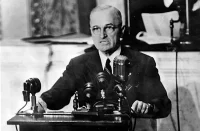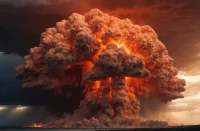Part I, Part II, Part III, Part IV, Part V, Part VI
The focal intangible factors of power and success in war
There are four focal intangible factors of power that have a direct impact on the success in war:
- Resolve: As a very matter of historical fact, all potential and real economic and military resources which a state possesses, in fact, have little value if a government lacks the will to use them or is unable to do that due to the lack of knowledge or technical possibilities. The question, however, arose: Is an actor determined to use capabilities for the sake to fulfill its ultimate foreign policy goals including the use of war as an instrument? Here, the example of the Vietnam War in 1965−1975 can be given when the US administration wearied of the prolonged warfare before the US foes did and were less willing to accept high casualties than were the Vietnamese.
- Leadership and skill: The questions are: Are political leaders of the actor able to rally citizens in support of their foreign policies? Can they effectively mobilize resources for the purpose to pursue their foreign policy? For instance, the US policy in Vietnam became ultimately undermined by the inability of US President Johnson to mobilize public support for the war.
- Intelligence: In this respect, we can ask two fundamental questions: Do decision-makers understand the foreign policy interests and political, economic, and military capabilities of potential enemies? Do they possess reliable information about enemies’ intentions and capabilities to realize their policy goals? For example, the absence of such information was a crucial obstacle to Western efforts to fight global terrorism.
- Diplomacy: From this perspective, we can ask the question: How effectively do a country’s diplomats represent its interests abroad? Effective diplomats can communicate and promulgate the foreign policy goals of their respective countries, gauge the interests and foreign policy goals of other states and actors, anticipates others’ actions, or negotiate compromises.
Explaining war between states
The causes of interstate warfare historically have long been a focal objective of political philosophers and modern social scientists. Genesis records two thousand years of history from biblical creation to the time of the first war. Never again would two thousand years pass – or even two hundred – without war.
It can be said that war is a concept that among the ordinary people refers to different types of activities. Nevertheless, conflicts understood as wars (however, concerning political sciences, only military conflicts between states can be defined as real wars) are widely different in their scope as they can range from internal violence/conflicts among subnational groups (i.e., the so-called civil wars) to confrontations between neighboring states, or even world wars – wars between many states on different continents. Wars, as well as are various in intensity as they can be from a few hundred deaths to tens of millions. Finally, was are different concerning the criteria of duration like from the 1967 Six-Day War up to the Hundred Years’ War (1337−1453).

From the very methodological standpoint, the first step in the complex process of analyzing war has to be to define and categorize the concept of war for the reason to assure that everyone is studying the same research phenomenon. For instance, in practice, it means to make difference between interstate wars (between states) and intrastate wars (within state). From the matter that scholars of IR have long focused on interstate relations, there are, therefore, many explanations of war between states. For instance, one widely accepted definition of interstate war is that it is a military conflict waged between or among national entities, at least one of which is a state, which results in at least 1000 battle deaths of military personnel. This definition of interstate war is on one hand surely arbitrary, but on another hand, it allows for the systematic collection and analysis of war data by researchers who share an identical definition of the phenomenon of war.
A typology of war was expanded to include, in addition to interstate war, extra-state wars between a state and a non-state actor outside its borders and intrastate wars between or among two groups within the borders of the same state (in fact, civil wars). In further analyses of war, it is necessary to introduce the factors that contribute to the outbreak of interstate war and consider how actors try to manage these factors to reduce the likelihood of war.
State as an abstract collective does not make decisions about peace and war but real people, with certain passions, ambitions, and physical and psychological limitations, in fact, make decisions. Consequently, at the individual level of analysis, explanations for war can be found in the nature and behavior of individuals (i.e., statesmen and politicians). In any case, if factors that trigger war cannot be changed, then policies cannot be fashioned to prevent its outbreak, and, therefore, it can be expected that sooner or late war will again erupt.
The desire for more power is one of the crucial classic realist arguments about the sources of war that look to human nature and in particular the lust for power. As a matter of fact, this desire to dominate applies to states and to individuals too. It can be said that it is a sin that drives humans to acquire more power. Humans are egoists with an innate desire to amass power and to dominate others. Consequently, the balance of power can be the only workable mechanism that can suppress human malevolence and malignant power.
A scientific variation of the desire for power finds the causes of war in human nature understanding war as a product of inherent aggressiveness. In fact, aggression is an instinct necessary for the preservation of the individual and humanity. Individual decision-makers as well play a crucial role in decisions to go to war.
Explaining intrastate wars
It is already a general approach in political sciences and IR that the end of the Cold War in 1990 marked a shift in the nature of war: a substantial increase in the number of intrastates (civil) wars. The world saw after 1990 a proliferation of ethnic, nationalist, religious, and other conflicts among subnational groups. Intrastate wars are much more prevalent today in global politics than interstate wars.
Understanding the real causes of intrastate wars is imperative in order to manage and prevent them. The civil wars destroy national economies, leaving civilian populations to live in poverty. However, intrastate wars can spill over into neighboring states and, therefore, become regional problems, especially in the cases when transnational ethnic communities became involved. We have to bear in mind that, in general, intrastate wars are of complex nature, and, therefore, several factors must be considered to explain the outbreak of any particular intrastate war.

In principle, there are several possible sources for intrastate wars at the general level. In political sciences and sociology, dominant explanations emphasize deep, historical animosities, conflicts over scarce resources, redressing past and present injustices, and security dilemmas arising from domestic anarchy. The most important of them are:
- Interethnic animosities: Interethnic animosities are in many cases a genuine cause of civil wars, even those that appear to be identity wars. There are explanations for interethnic warfare that stress ancient, or primordial, hates. Therefore, some ethnic groups have deep grievances that reach far back into history. In such cases, it is suggested that the only way to achieve peace (but not necessary and justice) is by the strong centralized authority (even dictatorship) and when such authority disappears, the conflict became reborn. This theory, for instance, explains inter-ethnic conflicts in the 1990s on the territory of ex-Yugoslavia. However, for many researchers, this theory is both controversial and unsatisfactory. In other words, if ancient hostility is the main factor in contemporary interethnic conflicts, then the long periods of peace among such groups are difficult to explain. Additionally, the theory suggests that it will virtually impossible to prevent future conflict, and, consequently, the future is looking bleak for many regions characterized by religious and/or ethnic heterogeneity. In reality, many ethnic and national groups are living together peacefully by solving interethnic disputes without war (like Slovaks and Czechs at the time of „Velvet Divorce“ which was finalized on January 1st, 1993). Therefore, according to some authors (like Paul Collier), conflicts in ethnically diverse countries can be ethnically patterned without being ethnically caused.
- Economic background: In some cases, historical animosities can be only an excuse for ambitious leaders but economic incentives and opportunities provide more persuasive explanations for inter-ethnic conflicts and civil wars. Many research results suggest that there is a higher possibility of interethnic warfare in low-income countries with weak governing structures that depend heavily on natural resources for their export earnings (like in Nigeria). Therefore, one rational-choice economic explanation is loot-seeking – war for private richness. Valuable natural resources as petroleum (Nigeria), diamonds (Sierra Leone), coal (Kosovo), or timber (Cambodia) offer reasons for conflict as they provide rebels with means to fund and equip their groups or if they win the war to grow from corruption. However, the mere presence of natural resources is not sufficient for interethnic conflict or any kind of civil war. In many cases, civil war is more likely to erupt if rebels have workers to take advantage of the resource and if a government is too weak to defend its natural resources. In principle, the loot-seeking argument focuses on the gain from the war itself. Leaders on all sides of the civil war create infrastructure in government and society to wage war and invest heavily in weapons and the training of soldiers. They profit personally from these investments and so have little incentive to stop fighting.
- Justice seeking: Another theory of interethnic wars suggests that civil wars may be a product of groups seeking revenge and justice for past and contemporary wrongs. In essence, such wars are likely to start when there is important social stratification, with large numbers of unemployed young people, political repression, or social fragmentation. Some theoreticians claim that people rebel when they receive less than they believe that they deserve and, therefore, seek to right economic and/or political injustice. Such groups claim that they are deprived of wealth that is given to other groups or that they are being denied a voice in the political system. However, it is not just recognizing deprivation that causes the civil wars. Rather, the incentives to rebel include a group’s perception that the deprivation is unfair, that others receive what they are denied, and that the state is unwilling to remedy the injustice. Nevertheless, this theory as well as tries to explain why both relatively privileged and deprived groups may mobilize.
- Security issues: Security issues can be a source of both interstate conflict and intrastate conflict too. In other words, security issues can be the source of conflict within states when the state authorities disintegrate and create a condition of domestic anarchy in which each group‘s efforts to defend itself appear threatening to others. The security issue is intensified by the inability to distinguish adequately between offensive and defensive weapons and the tendency of each party’s rhetoric to signal offensive intentions. Domestic security issue can be particularly severe because it is likely to be coupled with predatory goals, given the economic dimension to many civil conflicts.
Terrorism and war
Terrorism involves the threat or use of violence against noncombatants by either states or militant groups. It is a weapon of the weak to influence the strong that aims to demoralize and intimidate adversaries. The term “terrorist” is pejorative and is rarely used to describe friends. Nevertheless, terrorism as a special kind of warfare and politics is defined by the means used rather than the causes being pursued.
Terrorism is not a new phenomenon but several aspects of contemporary terrorist activity are, nevertheless, new:
- The level of fanaticism and devotion of contemporary terrorists to their cause is greater than their predecessors.
- Their willingness to kill large numbers of innocent people indiscriminately contrasts with their predecessors’ violence against specific individuals of symbolic importance.
- Many of the new terrorists are prepared to give up their own lives in suicidal attacks.
- Many of the new terrorist groups are transnational, linked globally to similar groups.
- Such terrorist groups make use of modern technologies like the internet, and some seek to obtain weapons of mass destruction.
The crucial question is arising: How should we respond to the threat of new-style terrorism? Yet despite some successes against new-style terrorism through conventional warfare, many critics are surely right to argue that in many cases the levels of violence, aims, and organizational structure of new-style terrorist groups differentiate them from conventional enemies like hostile states. Such situation has led many researchers to question the concept of a “war on terrorism” launched by US President George Bush, Jr. However, the debate about whether terrorism can be tackled through conventional warfare raises further questions regarding the relationship between terrorism and nation-state, like, for instance, Taliban Afghanistan, that have supported it.














Comments